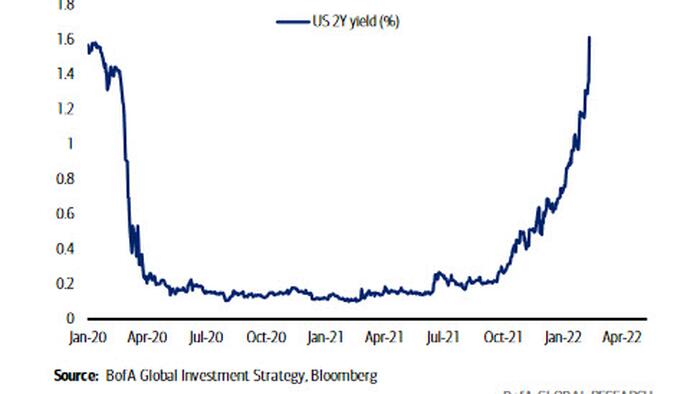BofA: If Rates Keep Rising, It Will Soon Be Time To Panic About Currency Debasement
BofA's bearish Chief Investment Strategist, Michael Hartnett, who has been dead on with his fire and brimstone forecasts for the past 6 months, must be getting tired taking victory laps (unlike his Goldman and JPM colleagues who like broken records only know how to repeat BTFD over and over at least until this week when their tune is set to change).
But one thing he may have whiffed on was his tongue-in-cheek suggestion that this weekend we could see an emergency rate hike by the Fed. In his latest Flow Show note titled "Saturday Hike Fever" Hartnett writes that on Saturday Oct 6th 1979 the Fed hiked 100bps (11% to 12%) in response to disorderly 12% inflation. Of course, now inflation is "only" 7.5%, and while there was rampant speculation that we may see an emergency rate hike imminently after the latest CPI print came in red hot - with Hartnett citing Thursday's probability of Fed hikes “intra- meeting” in next 3 weeks for 1st time since 1994 just jumped to >25% - this collapsed late on Friday after the Fed unveiled that it would continue its QE tapering until March 9, one week before the next FOMC meeting, taking an early/intermeeting hike off the table.
Yet just because the Fed didn't do an emergency rate hike doesn't mean that it isn't behind the curve: it is, and badly at that. As Hartnett notes, US inflation of 7.5% now exceeds Mexican inflation of 7.1%...
... which is rare, especially when considering that the Fed policy rate is 0% vs Banco de Mexico policy rate of 5.5%. It is hardly a surprise, however, that the highest US inflation since 1982 coinciding with Fed Quantitative Easing: indeed, the Fed has injected $200bn of liquidity into Wall St in past 27 trading days, a sum greater than market cap of Netflix.
And yet, the party is now ending: the recent surge in 2-year Treasury yield to 1.6% (above pre-COVID level)...
... on “inflation shock” & “rates shock” has coincided with massive reversal of QE/liquidity supernova era of outperformance of deflation assets (credit, PE, tech) vs inflation assets (commodities, Europe, banks)...
... also now coinciding with 2s10s yield curve just 46bps from inversion - which Hartnett believes will takes place "likely mid-year" precipitating a ”growth shock” in the second half (read: recession).
But before the recession, first we get inflation. Lots of inflation. First, here is some inflation math from Hartnett: in Jan, headline CPI was 7.5%, core 6.0% (highest in 40 years), and should torrid monthly gains of 0.6% MoM in core CPI continue, year-end inflation will be 7-8%, moderation to "just" 0.4% per month means year-end inflation of 5-6%; this means that the US need 0.2% inflation every month to get core CPI to 3% by end-‘22.
Regardless of where inflation goes next, the far bigger problem is where it is now:
* food up 20% YoY,
* house prices/rent up 10-20% YoY,
* energy (gas/oil) up 40-50% (note higher energy costs structural due to underinvestment in energy - profits up 4X since 2017 vs capex -30%);
* wage surge continues...small business compensation at at all-time highs);
As Hartnett puts it, "call it what you will (wage-price spiral, 2nd -round effects, unanchored expectations)...it ain't transitory"
And now that even the market realizes what we have been saying since the spring of 2021 - namely that inflation is all too permanent - the tale of the tape speaks volumes. Here are the highlights per Hartnett:
big tops/losses in EM, long duration tech, crypto past 12 months lead indicators of rates shock; XBT holds $40k, XBI crawls above 100, EEM>$50 tactical tells that rates shock close to “priced-in”; new highs in FTSE shows Fed tightening into “reopening” not “slowdown”; in contrast weak in oil, housing (lumber), bank stocks, monopolistic stocks (i.e. FAANMG), US dollar = beginning of negative "growth shock.
And speaking of Hartnett's three favorite topics for 2022, the rates shock, the volatility shock and the debt shock, he recaps his key points below:
“Rates shock": Fed is desperately behind-the-curve but now set to hike aggressively in H1; aggressive Fed at moment of overvalued asset markets not normally recipe for big returns (BofA is bearish but “tops are a process”, “they are yet to hike so no reason why economy immediately dives lower”, even so the carnage below surface of credit and equity indices has been savage...46% of all Nasdaq companies were >50% below 52-week highs one week ago).
* * *
“Volatility shock”: that all said, the risk of volatility, disorderly capital flows, credit events is very high especially given policy divergences emerging:
* 1. China easing total social financing record CNY 6.17tn in Jan, and policy rates (PBoC cuts 1Y Loan Prime Rate 15bps to 3.70%);
* 2. ECB and especially BoJ paranoia over ending zero rates/QE/YCC policies (despite minimal evidence the policies have boosted domestic economies past 2/10/20 years );
* 3. dovish peripheral central banks...e.g. Swedish Riksbank promising not to raise rates until 2024; monetary policy divergences = volatility; volatility = -ve asset returns; Fed “put” is SPX 3800-4000, IG spreads 150bps.
“Debt shock”: table 1 outlines CBO projections for debt held by public, interest rate assumptions, interest payments and debt/GDP.
CBO sees cumulative $4.6tn in interest paid through 2031 as baseline...but if 7-year yields are 50bp above CBO projections (and in line with current market expectations) US interest rate servicing jumps to $6.2tn; and if 7-yield averages 100bps higher than low CBO expectations in next 10-years, US interest rate servicing jumps to $7.8tn...a sum larger than the entire US debt back in 2005; should yields & rates in US rise at same time as US dollar falls, US currency debasement fears will grow.
Tyler Durden
Sun, 02/13/2022 - 21:14
http://dlvr.it/SJwdD1

No comments:
Post a Comment